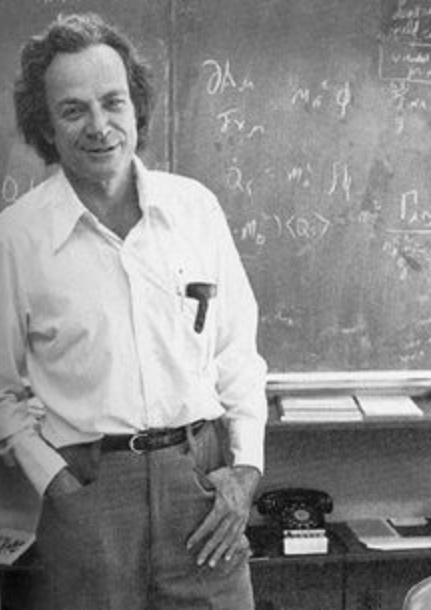

According to R.J. Cook & G.V. Wood (2004). Feynman's Triangle. Mathematical Gazette 88:299-302, this triangle result puzzled famous physicist Richard Feynman (1918-1988) in a dinner conversation:
For a triangle ABC in the plane, if each vertex is joined to the point (1/3) along the opposite side (measured say anti-clockwise), then area ABC = 7 x area UWV (the inner triangle formed by these lines).
Feynman's Triangle
Challenge
Can you prove the above result? Can you prove it in more than one way?
For an elementary proof, easily accessible at secondary school level, see the visual proof by Steinhaus (1960) at Wikipedia (One-seventh area triangle) in the references below.
Investigate Further
1. Can you generalize to find a formula for a triangle ABC in the plane, when each vertex is joined to the point (1/p), along the opposite side (measured say anti-clockwise)?
2. In the dynamic sketch above, click on the button 'Link to ... general investigate 1' and use the sliders to investigate Question 1 above. After investigating, click on the next 'Link to ... general formula 1' button to check your solution.
3. Can you generalize even further if the 3 sides of the triangle are each divided into different ratios? Click on the 'Link to ... Routh formula" to check your answer. For an elementary proof of Routh's Theorem (1896), easily accessible at secondary school level, see Y.K. Man (2009) in the references below.
Parallelogram Generalization
4. Can you generalize the Feynman result for a triangle to a parallelogram?
5. Have a look at Feynman Parallelogram Generalization and use the slider for p to investigate Question 4 above.
Investigate Variations
Also investigate the following variations for a triangle and a parallelogram - use the 'Link' buttons to navigate from the one variation to the other: Feynman variations.
Bibliography & Related Links (according to date)
De Villiers, M. (2005). Feedback: Feynman's Triangle (extended to Parallelogram). The Mathematical Gazette, 89 (514), March, p. 107.
Todd, P. (2006). Feynman's and Steiner's triangle. The Journal of Symbolic Geometry, pp. 85-90.
Clarke, R.J. (2007). A generalisation of Feynman's triangle. The Mathematical Gazette, Vol. 91, No. 521 (Jul.), pp. 321-326.
Man, Y.K. (2009). On Feynman's Triangle problem and the Routh Theorem. Teaching Mathematics & its Applications, 28(1):16-20.
Hindin, H.J. (2010). From Feynman to Fibonacci And More. Paper presented at the Fifth Annual Spuyten Duyvil Mathematics Conference, St. Francis College, Brooklyn, New York, April 24, 2010.
Lingefjärd, T. (2015). Learning Mathematics through Geometrical Inquiry. At Right Angles, March, Vol. 4, No. 1, pp. 50-55.
Wikipedia (last accessed 13 July 2021). One-seventh area triangle.
Nestor Sánchez León. (31 July 2021). Generalización del triángulo de Feynman, an interactive GeoGebra page.
Related Links
Feynman Parallelogram Generalization
Feynman Triangle & Parallelogram Variations
Area Parallelogram Partition Theorem
Some Parallelo-hexagon Area Ratios
Area ratios of some polygons inscribed in quadrilaterals and triangles
International Mathematical Talent Search (IMTS) Problem Generalized
A Geometric Paradox Explained (Another variation of an IMTS problem)
Euclid 1-43 Parallelogram Area Theorem
The theorem of Hippocrates (470 – c. 410 BC)
Triangle Area Formula in terms of angles, r & R
A Surprising Constant Area Sum Involving Translating Figures
Cross's (Vecten's) theorem & generalizations to quadrilaterals
Area Formula for Quadrilateral in terms of its Diagonals
Maximum area of quadrilateral problem
The Equi-partitioning Point of a Quadrilateral
The Orthocentre Quadrilateral of a Quadrilateral
Minimum Area of Miquel Circle Centres Triangle
Maximising the Area of the 3rd Pedal Triangle in Neuberg's theorem
External Links
Richard Feynman (Biography at Wikipedia)
One-seventh area triangle
***************
Back to "Dynamic Geometry Sketches"
Back to "Student Explorations"
Created by Michael de Villiers, Sept 2009; modified 26 July 2021; updated 1 August 2021; 8 Dec 2023; 1 Oct 2025.